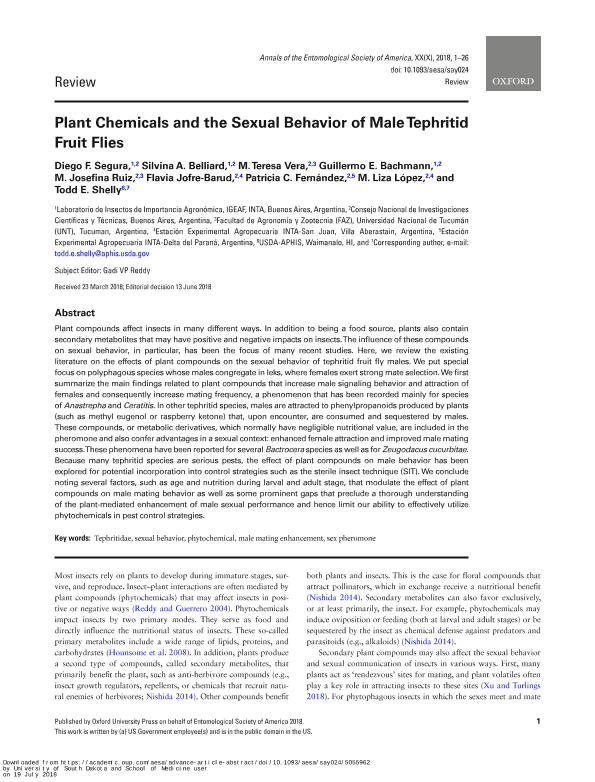Artículo
Plant Chemicals and the Sexual Behavior of Male Tephritid Fruit Flies
Segura, Diego Fernando ; Belliard, Silvina Anahí
; Belliard, Silvina Anahí ; Vera, María Teresa
; Vera, María Teresa ; Bachmann, Guillermo Enrique
; Bachmann, Guillermo Enrique ; Ruiz, María Josefina
; Ruiz, María Josefina ; Jofré Barud, Flavia Beatriz
; Jofré Barud, Flavia Beatriz ; Fernandez, Patricia Carina
; Fernandez, Patricia Carina ; López, María Liza
; López, María Liza ; Shelly, Todd E.
; Shelly, Todd E.
 ; Belliard, Silvina Anahí
; Belliard, Silvina Anahí ; Vera, María Teresa
; Vera, María Teresa ; Bachmann, Guillermo Enrique
; Bachmann, Guillermo Enrique ; Ruiz, María Josefina
; Ruiz, María Josefina ; Jofré Barud, Flavia Beatriz
; Jofré Barud, Flavia Beatriz ; Fernandez, Patricia Carina
; Fernandez, Patricia Carina ; López, María Liza
; López, María Liza ; Shelly, Todd E.
; Shelly, Todd E.
Fecha de publicación:
09/2018
Editorial:
Entomological Society of America
Revista:
Annals of the Entomologycal Society of America
ISSN:
0013-8746
Idioma:
Inglés
Tipo de recurso:
Artículo publicado
Clasificación temática:
Resumen
Plant compounds affect insects in many different ways. In addition to being a food source, plants also contain secondary metabolites that may have positive and negative impacts on insects. The influence of these compounds on sexual behavior, in particular, has been the focus of many recent studies. Here, we review the existing literature on the effects of plant compounds on the sexual behavior of tephritid fruit fly males. We put special focus on polyphagous species whose males congregate in leks, where females exert strong mate selection. We first summarize the main findings related to plant compounds that increase male signaling behavior and attraction of females and consequently increase mating frequency, a phenomenon that has been recorded mainly for species of Anastrepha and Ceratitis. In other tephritid species, males are attracted to phenylpropanoids produced by plants (such as methyl eugenol or raspberry ketone) that, upon encounter, are consumed and sequestered by males. These compounds, or metabolic derivatives, which normally have negligible nutritional value, are included in the pheromone and also confer advantages in a sexual context: enhanced female attraction and improved male mating success. These phenomena have been reported for several Bactrocera species as well as for Zeugodacus cucurbitae. Because many tephritid species are serious pests, the effect of plant compounds on male behavior has been explored for potential incorporation into control strategies such as the sterile insect technique (SIT). We conclude noting several factors, such as age and nutrition during larval and adult stage, that modulate the effect of plant compounds on male mating behavior as well as some prominent gaps that preclude a thorough understanding of the plant-mediated enhancement of male sexual performance and hence limit our ability to effectively utilize phytochemicals in pest control strategies.
Archivos asociados
Licencia
Identificadores
Colecciones
Articulos(CCT - MENDOZA)
Articulos de CTRO.CIENTIFICO TECNOL.CONICET - MENDOZA
Articulos de CTRO.CIENTIFICO TECNOL.CONICET - MENDOZA
Articulos(CCT - NOA SUR)
Articulos de CTRO.CIENTIFICO TECNOL.CONICET - NOA SUR
Articulos de CTRO.CIENTIFICO TECNOL.CONICET - NOA SUR
Articulos(SEDE CENTRAL)
Articulos de SEDE CENTRAL
Articulos de SEDE CENTRAL
Citación
Segura, Diego Fernando; Belliard, Silvina Anahí; Vera, María Teresa; Bachmann, Guillermo Enrique; Ruiz, María Josefina; et al.; Plant Chemicals and the Sexual Behavior of Male Tephritid Fruit Flies; Entomological Society of America; Annals of the Entomologycal Society of America; 111; 5; 9-2018; 239-264
Compartir
Altmétricas



